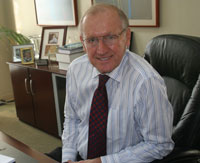City Capital Spending Shows Decline

April 9, 2012
Around Town – By Neal Tepel
Capital spending by the City of New York will remain near record levels through Fiscal Year 2013, according to a New York Building Congress analysis of the City of New York’s Preliminary Fiscal Year 2013 Budget. However, the longer-term forecast of spending and new commitments drops to levels not seen since the middle of the last decade.
Highlights of the Capital Commitment Plan
• In the current 2012 fiscal year (July 1, 2011-June 30, 2012), capital spending is anticipated to reach $9.4 billion, higher than all but the two peak years of this administration; and the fourth-highest inflation-adjusted outlay in thirty years.
• Capital Commitments (contracts registered with the Comptroller’s Office) for 2012 are anticipated to be the highest of any year of this administration, at $11.8 billion, indicating that actual spending in the near term will remain strong.
• The forecast for Fiscal Year 2013 includes $8.75 billion in spending and $9.1 billion of new commitments, further assuring a stable flow of public work in the near term.
• After 2013 there is a steady decline in the City’s planned expenditures and commitments, which means less infrastructure spending and construction.
Shrinking Commitment Plan The total commitment plan for Fiscal Years 2013-2015 is $21 billion, the smallest three-year plan since January 2004. After robust commitments of $9.1 billion in 2013, the number drops to $6.8 billion in 2014 and $5.1 billion in 2015.
Declining Expenditures The Fiscal Year 2013 Preliminary Capital Budget also forecasts actual spending over four years of $32.3 billion. In historical terms, this is high. However, it is a significant decline from the peak years of the past decade. The last time the City forecast a four-year spending plan this low was Fiscal Year 2006. Alongside decreases in spending and new commitments, the City is forecasting a commensurate decline in borrowing, from $7.4 billion in the current fiscal year to $5.4 in Fiscal Year 2016, a 27% drop in debt financing.
Richard T. Anderson, President of the Building Congress said, “As the City’s economic outlook improves, increasing capital expenditures must remain a first tier priority. Capital investment ensures that schools, cultural institutions, roads, bridges, mass transit, parks and innumerable other public facilities provide a high quality of life, attract investment, and keep the City livable. Disinvestment in infrastructure ultimately leads to the erosion of the City’s tax base. These investments are not luxuries, but critical linkages that bind the City’s and the region’s economy, support job growth and continued private investment.”



